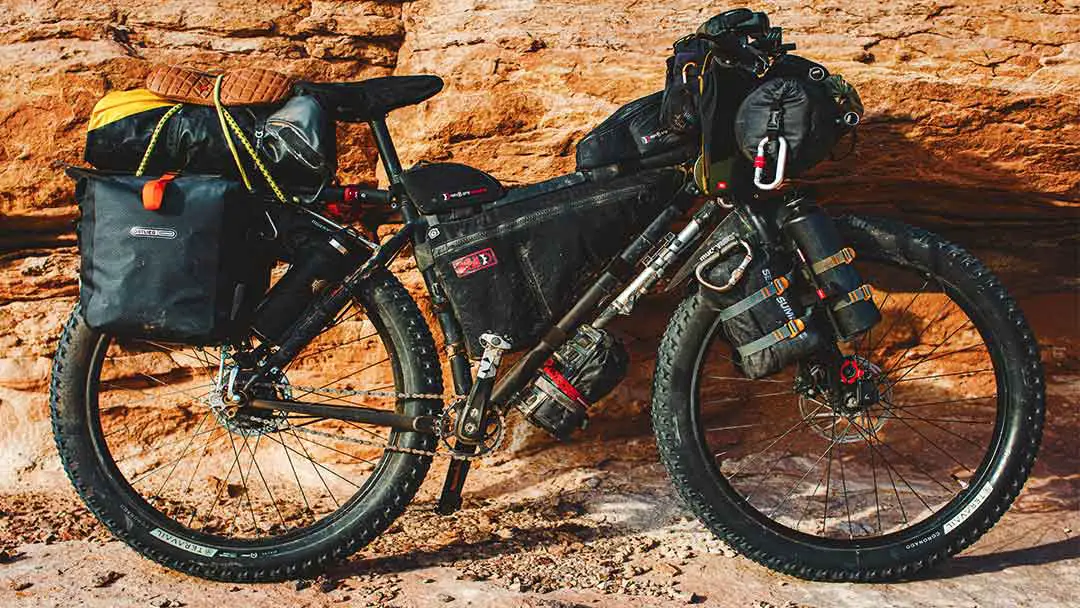How To Use Voile Straps for Bikepacking

As an Amazon Associate we earn from qualifying purchases made on our website. If you make a purchase through links from this website, we may get a small share of the sale from Amazon and other similar affiliate programs. You can read our complete legal information for more details. By using this site, you agree the information contained here is for informational purposes only. For specific medical questions, consult your doctor. NO information on this site should be used to diagnose, treat, prevent or cure any disease or condition.
Have you ever gone camping and had difficulty squeezing your sleeping bag and tent back into your bags? That always frustrated me so much. Luckily, you can use straps and help hold them secure and squeeze inside smaller spaces!
Viole straps can be used in bikepacking for securing bags, bottles, and packages. They’re versatile, strong, and effective at keeping your supplies safe. The buckles make securing supplies simple since you can simply wrap the strap around your bags and clip it with the buckle.
What are Viole straps exactly? Are Viole straps the same thing as Viole material? How do you properly secure your supplies? We have all these answers and more, so keep reading!

What is a Voile Strap?
A Voile strap is a name brand used to refer to a type of strap originally intended to bind skis.
They’re made from polyurethane and other flexible materials. This allows these straps to be used in various ways without snapping, breaking, or weakening.
Voile straps were first invented over 30 years ago for outdoor and adventure enthusiasts. However, the material wasn’t always used for sporting escapades.
The term “Voile” comes from the French word for “veil.” This is because the material was made from a blend of cotton, polyurethane, and other lightweight materials. This makes the fabric sheer and thin.
This material was originally made from cotton, silk, and other natural materials. However, they’ve since been made from soft plastic fibers and polyurethane.
They’re a favorite to use in various sewing projects and are famous for bridal designs. While soft and gentle, they maintain a firm and strict fiber that’s hard to break.
Voile straps are an innovation, though. The commonalities between the sporting strap and bridal gowns may seem minimal, but their similarity is in the material itself.
The uses may differ significantly, but voile material is used in both because of its lightweight and strength. Voile might make the perfect bridal gown, but with some innovation, they also make the ideal sports strap!
According to the Voile website, they aren’t French and didn’t necessarily intend this similarity. Instead, “voile” was a common term among sports and backcountry enthusiasts.
Therefore, the similarities might be a mistake or coincidence. But the fact remains that both are used to refer to a light yet strong material that’s equally versatile.
How Do You Use Voile Bike Straps?
Voile bike straps are used primarily to strap bottles, water bottles, bags, and other gear to the bike’s frame.
Their original use might have been for skiing, but they’re also popular for different sporting activities. Voile is sometimes used by hikers, mountain climbers, kayakers, and bikers.
Above I explained the origins of the term “voile,” but here we’ll discover how they’ve evolved.
Voile straps originally addressed the struggle many skiers had carrying their gear. Duct tape was the norm back then, but it was insufficient in the wet climate.
Voile straps were created to substitute things like duct tape. These straps are flexible and string, with a convenient belt buckle on the end of it.
This makes for a suitable, waterproof, and strong strap to carry your supplies no matter the weather.
While we highly recommend bringing duct tape with you on your travels, there are better options for wet weather. That’s where voile straps come in handy.
You can add voile straps in several ways while bikepacking:
- Strapping tent to your bike frame
- Strapping bottles to your lower bars
- Preventing food and clothes from getting wet
Wrapping your supplies in plastic is an excellent idea, especially for your food. Voile straps make this a much easier and more effective task than other binding materials.
There are several varieties of straps for tying and securing your gear. But, Voile is the best for larger bags.
We’ll briefly jump into when and where to use these different types of straps and bags. But you can also check out this great comparison between Voile straps and Tailfin!

What Are the Best Ways to Carry Supplies While Bikepacking?
Backpacks are the classic way to carry your luggage and water while bikepacking. However, they are limited in space, and thus you might need to find creative ways to use your bike frame.
Rope, bungee cords, Voile straps, and other binding straps will help make this possible!
Backpacks
Backpacks are in the name, bikepack! This is where most people start their journey by adding water and gear to their bikes.
Backpacks are one of my favorite packing tools because of their convenience.
While on the road, backpacks allow you to pause easily and pull out your supplies. Backpacks are an excellent spot to keep ponchos, raincoats, or an easily accessible change of clothes.
While traveling, you won’t want to stop and unpack all your packs just to find a raincoat. For this reason, I recommend keeping any emergency gear in your backpack to avoid having to dig around for it.
Use backpacks to store the following items:
- Bandages and purifying alcohol or hydrogen peroxide
- Raincoats
- Poncho
- Tape
- Flashlight
- Electronics
Bags
Bags may sound a little vague. When we use this term when concerning bikepacking, we’re referring to saddlebags, frame bags, and cellphone mounts.
These bags attach conveniently to various parts of your bike frame. They make efficient use of space and build, which makes them ideal for bikepacking.
Use these bags to store some of the following items:
- Cellphone and small electronics
- Tent
- Food
- Extra water
- Blankets
Straps on Handlebars
Straps such as the Voile strap and Tailfin straps are excellent tools on the road. Both of these straps are great, but I recommend using them differently.
The Tailfin strap is great for attaching cylindrical objects (like water bottles) to your bike. They’re stiffer and less flexible than Viole straps.
Viole straps, on the other hand, are great for making your gear secure and compact. This is similar to how bungee cords are commonly used, except Viole straps are more secure.
Also, I discuss 6 other ways you can strap on water bottle holders without drilling holes here.
What Should You Not Bring Bikepacking?
You should avoid bringing excess supplies which don’t serve immediate purposes. Excess weight will only drag you down and cause you to expend energy unnecessarily. Consider leaving behind extra multi-tools, large spare tires, and specialized shoes.
While it’s crucial to bring emergency supplies with you on the road, don’t overdo it. Bikepacking.com offers a helpful breakdown of what you should avoid taking on the road. Some of these include:
- Extra multitools (normally, a Swiss pocket knife should suffice)
- Large extra tire treads
- Fancy, unnecessary shoes (good to bring two pairs, though)
- Excess food
- Excess water
We also created a free bikepacking printable PDF checklist which you can download here.
How Do You Bikepack With Viole Straps?
Voile straps are primarily used to secure bags and loose items on your bike when bikepacking.
This is achieved by wrapping the strap around the object (bag, bottle, etc.) and securing the belt. This belt is designed to hook easily, and you can feel free to stretch the strap a little while attaching it.
As we mentioned above, Viole straps were first invented for skiing. However, how you attach the belts together is virtually the same for bikepacking and skiing.
This tutorial is very useful in demonstrating how these straps hook and remain secure. When seeking to secure your items to your bike, though, the process can be more difficult.
This is especially true for large bulky bags.
To properly secure your items to your bike, use the following steps:
- Attach your bag to your bike using a bungee cord or string (this will hold it in place temporarily)
- Select the appropriate-sized Viole strap
- Standard
- XL series
- Choose the appropriate buckle
- Nylon
- Metal
- Secure with 1-3 straps depending on the size and weight of the bag
When choosing your Viole straps, you must know what you plan to bring. While these straps are flexible and durable, they shouldn’t be stretched excessively. This can cause the strap to weaken or snap while you ride.

Are Voile Straps Worth It?
Voile straps are worth it, especially on long bikepacking trips and camping trips. They help ensure your items don’t fall off while you ride. They also bind items more securely so they don’t sag and drag the flow of the bike.
Viole straps are sturdy, waterproof, and affordable. They typically cost between $8.00-$16.00 each, depending on the size and capacity.
You can check Amazon Voile Strap pricing here.
While more costly than duct tape and twine, they’re more durable and efficient.
You won’t have to worry about the straps becoming damaged by the sun or rain since they’re UV and weather-resistant!
While you might not need them on short 1-3 day trips, they’re perfect if you need a tool to help secure your supplies for long excursions!
Closing Thoughts
Viole straps have a confusing name and unique backstory. Despite their similar name to thin bridal material, they are made for rugged outdoor adventures!
I hope this article helped clear up any confusion about these straps. I highly recommend them for your next bikepacking journey since they’ll give you peace of mind.
You won’t have to worry about rain or shine; they’ll stay secure and steady all the way!
While on the subject of biking, you will find these two articles useful:
- Touring Bike Vs. Road Bike Compared- Which Is Better?
- Bikepacking VS Touring Compared | What’s The Difference?
Sources:
Traveling Two: 10 Reasons To Bike Tour With Duct Tape
Exploring Wild: Creative Gear Ideas For Bikepacking On A Budget
The Nxrth: VOILE STRAPS VS TAILFIN CARGO STRAPS: WHICH IS BETTER FOR BIKEPACKING?
Bikepacking: Backpacks fit for bikepacking
Amazon: The Mass Shop Bike Frame Bag, Bags for Bicycles
Amazon: Kulie Bicycle Phone Holder| Universal Top Tube Handlebar Bag with Cellphone Mount
Bikepacking: 10 Items NOT to Bring Bikepacking



